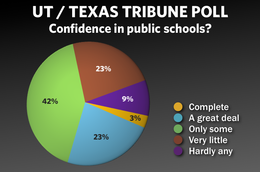How should we rate public schools? Let’s see what different measure say and consider what “accountability” should tell us.
The Texas Education Agency (TEA) just issued their 2010 “Accountability Ratings.” The table below summarizes these ratings of campuses over the last four years. My percentages are slightly different from those reported by TEA because I’ve excluded those campuses that TEA could not rate. The number of schools they fail to rate varies from year to year and make comparisons across time harder.
| Rating |
2010 |
2009 |
2008 |
2007 |
| Exemplary |
33.7% |
22.3% |
10.5% |
6.8% |
| Recognized |
40.5% |
30.4% |
29.6% |
25.1% |
| Academically Acceptable |
24.2% |
23.9% |
36.8% |
43.8% |
| Academically Unacceptable |
1.6% |
2.5% |
2.1% |
2.9% |
Overall, TEA thinks we’re making great strides. Over the last four years the number of “exemplary” campuses has expanded dramatically. One in three campuses rate “exemplary” and three of four rate as “exemplary” or “recognized.”
Some of the changes in the rating result from TEA utilizing a “growth measure” that the TEA has labeled the Texas Projection Measure. The measure has been controversial and began getting attention before the results were released. I’ll leave much of the debate over the measure to others. However, I believe that the measure is a failure if the Texans it was designed to inform don’t understand and trust these accountability standards.
There are other measures of success. The College Board has recently released a report that pulls together a variety of statistics that compare education across the states. I pulled together a number of these measures that relate to the success of education in Texas. The table makes clear that Texas is lagging behind other states in a number of key indicators.
| Measure |
Texas |
National Average |
Rank |
| Average Graduation Rates for Public High School Students, 2006 |
72.5% |
73.4% |
35 |
| Percentage of Public High Schools Offering Advanced Placement in the Four Core Subject Areas, 2009 |
38.0% |
33.9% |
24 |
| Estimated Rate of High School Graduates Going to College by State Rank, 2006 |
55.4% |
62.0% |
41 |
| In-State Tuition Prices at Public Two-Year Institutions by State Rank, 2010 |
$1,736 |
$2,982 |
4 |
| In-State Tuition Prices at Public Four-Year Institutions by State Rank, 2010 |
$7,724 |
$6,784 |
34 |
| Full-Time Freshman-to-Sophomore Retention Rates at Public Two-Year Institutions by State Rank, 2007 |
57.8% |
59.0% |
18 |
| Full-Time Freshman-to-Sophomore Retention Rates at Public Four-Year Institutions by State Rank, 2007 |
72.8% |
78.0% |
40 |
| Three-Year Graduation Rates of Associate Degree–Seeking Students by State Rank, 2007 |
18.% |
27.8% |
40 |
| Six-Year Graduation Rates of Bachelor’s Degree–Seeking Students by State Rank, 2007 |
50.2% |
56.1% |
32 |
| Adults Ages 25–64 with Less Than a High School Diploma by State Rank, 2008 |
13.2% |
11.3% |
50 |
| High School Graduates Going to College by State Rank, 2006 |
55.4% |
62.0% |
41 |
| Percentage of 25- to 34-Year-Olds with an Associate Degree or Higher, 2008 |
27.4% |
41.6% |
41 |
Some Texas politicians have suggested that the various drop out rates and other statistics don’t give an accurate picture of Texas’ success. While the range of statistics in the table above makes some pretty compelling evidence of Texas’ problems, we can also find some evidence in Texas public opinion.
A Texas Tribune/University of Texas poll reveals that most Texans have some serious about their schools. When asked how much confidence they had in Texas public schools on 3% said that have “complete confidence” and 23% said “a great deal of confidence.” At the other end of the scale, 23% said they had “very little” and 95 reported “hardly any confidence at all.” Another question revealed that 61% of respondents thought that academic standards were too low. That’s a pretty dramatic contrast to TEA’s assessment.

Education policy in Texas (and other states) has increasingly focused on “accountability.” Teacher were given tests and fired if they didn’t pass. Students were given state tests (and then more tests, and then a different test, and then…) and teachers found themselves accountable for students’ scores.
State officials try to build political careers by telling voters that “not all wisdom resides Washington.” Unfortunately, they’ve replaced this with the assumption that all wisdom resides in Austin. We’ve been going down that path for over a decade and schools have not improved. If anything, the state’s schools have suffered from the strict regiment of state testing and other state bureaucratic mandates. In short, the state’s expensive remedies proved worse than the problems (if there were actually problems at the time). On top of that, the politics of the Texas State Board of Education has made it a laughing-stock.
All of the indicator not massaged by the state itself tell us that the state has failed. Maybe it’s time to trust teachers, principals, superintendents, and the elected school boards that hire them.
**Update**
The TEA gave up on this new measure in April 2011. [Story]
Filed under: Education Policy | Leave a comment »



